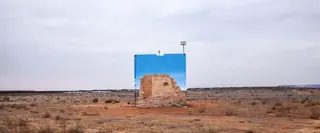In Samper de Calanda, a small rural town in the province of Aragon, Spain, a vulnerable species is facing serious conservation challenges. We’re talking about kestrels, small falcons resident in the Iberian Peninsula whose natural habitat has been significantly reduced in recent years. This is how ‘PrimillArt’ arose, a pilot project that combines renewable energy with the protection of biodiversity and art.
In partnership with the University of Zaragoza (UNIZAR) and the Aragon Agro-Food Research and Technology Centre (CITA), Galp is developing a Renaturalisation Plan for solar energy parks in the Aragon region. This plan aims to protect and boost local biodiversity, promote the renaturalisation of the ecosystem, and regenerate the soil, among other benefits. So far, several birdlife monitoring actions have been carried out and some of the initiatives have been implemented, including the planting of aromatic and medicinal species (artemisia, thyme and santolina) between the photovoltaic panels and, on part of the land, the installation of hotels for pollinating insects and shelter boxes for birds and bats. “We did so by building small shelters for these birds, thereby providing direct assistance in the conservation of the species”, Carlos Relancio, director of Renewables at Galp, tells Energiser.
One of these shelters lies close to the Talento photovoltaic power plant and is now an outdoor artistic exhibition, which has completely transformed a cement structure into a work of art, perfectly integrated into the landscape. “We added a cultural dimension to the protection of biodiversity and renewable energy in the ‘PrimillArt’ project”, explains the director of Renewables. A movement that provides guest street artists with the chance to paint the shelters with well-known features of local culture and values, thereby ensuring the structure blends smoothly into the landscape. “In addition to producing clean energy, our renewable solar energy parks help in the conservation of species and serve as open-air art galleries”, he reinforces.


